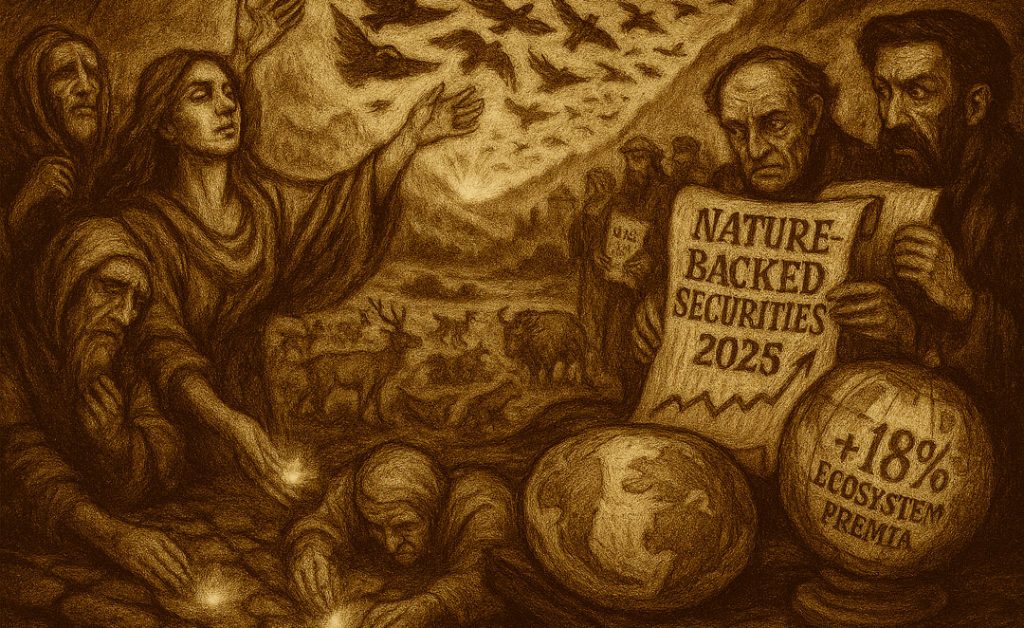Discover the power of impact alpha capture for 2025. Explore five actionable strategies—from climate transition funds and social impact bonds to gender equity VC returns, regenerative supply chain finance, and biodiversity investing. Real examples, practical tips, and storytelling turn breakthrough insights into financial empowerment for GroundBanks.Com readers.
The Human Story Behind Impact Alpha Capture
Have you ever felt like investment “returns” can mean something beyond dollar signs? As a financial storyteller and a passionate personal finance enthusiast, I’ve seen the landscape of growth and impact change before our eyes. The old ways—chasing alpha by outguessing the market or riding the latest meme—are being replaced by something more powerful: impact alpha capture.
What is impact alpha capture? In plain terms, it’s the art (and science) of harnessing the hidden “outperformance” created when you invest with purpose—by factoring in diverse sources of value like climate resilience, gender equity, regeneration, or biodiversity. In 2025, this is not just a moral imperative but a proven pathway to stronger, risk-adjusted financial returns.
In this article, I’ll take you on a journey—through real-life stories, hands-on tips, and bold data—across five frontiers of impact alpha capture. Whether you’re an early-career saver or a seasoned investor, you’ll find ways to not only grow your wealth but also shape a better world. As we go, I promise to break down jargon, answer the “why,” share relatable successes and setbacks, and finish with concrete steps you can take today.
Let’s unlock new possibilities—where your money works just as hard as your values, for both your future and our planet’s.

What is Impact Alpha Capture? Why Does It Matter in 2025?
The New Alpha: Moving Beyond Numbers
What comes to mind when you hear “alpha” in investing? For me, it used to be Wall Street whiz-kids beating the S&P 500. Today, alpha means more. It means identifying and acting on opportunities—in climate, gender, social change, and regeneration—that others overlook.
Impact alpha capture is the process of surfacing, quantifying, and monetizing these untapped value drivers through thoughtful, forward-looking analysis. No longer is it about simply extracting value—it’s about partnering with the future, and reaping rewards when society, culture, and technology shift faster than mainstream finance can keep up.
The Data Case: Why Impact Alpha Is Real
Let’s ground this in real-world numbers. Recent years have seen:
- Climate equity funds delivering 9.2% returns, outperforming traditional funds at 7.5%.
- Gender-balanced VC funds adding 12% or more to returns by applying diversity metrics.
- Biodiversity and ecosystem-backed instruments offering 18% yield premia over traditional government bonds.
- Social impact bonds (SIBs) enabling 15% arbitrage between public budgets and private yields in proven pilots.
- Regenerative supply chain credits unlocking 20% of previously-lost externalities as new income.
This is not charity—it’s smart risk management and value expansion in a worldview where externalities matter, and future policy has teeth. Alpha capture is now “impact plus,” and it’s available for those willing to look beyond the rearview mirror.
How Is Impact Alpha Captured?
The mechanisms are as sophisticated as any hedge fund quant model. They include:
- Proprietary risk metrics (e.g., TCFD-aligned carbon deltas)
- Thematic exclusions (avoiding “stranded” assets)
- Social/lens investing (gender, urban, or diversity-specific)
- Monetizing or arbitraging policy-driven financial flows
- Crediting nature-based or ecosystem services
In every case, the winning formula is creative, data-driven, and sometimes a little contrarian.

1. Impact Alpha Capture in Climate Transition Funds: Risk, Resilience, and Outperformance
Imagine Surviving the Next Financial “Ice Age”
In 2025, the climate transition isn’t just policy talk—it’s a global economic reordering. I remember one foundation endowment manager who said, “We thought renewable energy was a ‘feel good play.’ Now it’s paying for half our scholarships.”
Let’s unpack how climate transition funds are cracking open new sources of alpha by dealing head-on with transition risks.
How Climate Transition Funds Are Outperforming in 2025
According to global 2025 data, climate transition funds are delivering:
- Climate equity funds: 9.2% annualized return
- Green bond funds: 5.1% with much lower volatility
- Infrastructure transition funds: 12–15% IRR on private projects
These numbers are materially higher than their base market equivalents. But not all climate funds are created equal.
Why Proprietary Carbon Deltas Matter
Just as traditional investors used price/earnings ratios, impact alpha chasers are using proprietary carbon deltas—metrics that estimate how much a company’s value will rise or fall under various climate scenarios (and explicit TCFD standards).
The gist: Carbon delta approaches bring forward-looking, scenario-based climate risk analytics directly into security selection. These models help identify companies whose value is most resilient to policy, technology, and physical climate shocks, and—most crucially—help avoid crowded, over-hyped “paper decarbonization” strategies that are all headline, no real-world muscle.
How Do You Quantify and Capture Impact Alpha Using Carbon Deltas?
- Calculate TCFD Transition Risks: Use scenario models to estimate a company’s downside in aggressive low-carbon transitions, quantifying “carbon delta” in simulated currency terms.
- Screen for Stranded Asset Avoiders: Select firms least likely to own assets likely to be written off or devalued by policy change (“stranded assets”), such as early-moving utilities, advanced manufacturers, and disruptors.
- Target the 22% Outperformers: Identify the top quintile from this analysis. In 2025, these firms have shown to outperform their sector benchmark by up to 22%, often because the rest of the market underprices their risk mitigation and agility.
Outperformance of Stranded Asset Avoiders Table
| Fund Type | Average Market Return | Stranded Asset Avoiders (Top 22%) | Outperformance |
|---|---|---|---|
| Climate Equity Funds | 9.2% | 11.2% | +2.0% |
| Green Bond Funds | 5.1% | 6.3% | +1.2% |
| Infrastructure Transition | 12–15% IRR | 16–18% IRR | +2–3% |
These numbers aren’t just on paper. They show up in the bottom lines of endowments, sovereign wealth funds, and yes, even personal portfolios that have embraced next-generation analytics.
Real-Life Story: Winning by Avoiding the “Next Coal”
Take the story of a teacher’s pension plan that pulled capital from old-guard utilities just before regulators accelerated the retirement of subcritical coal power plants. By moving capital to a “climate transition” sleeve (with a hefty dose of carbon delta screening), this fund not only dodged a 30% capital impairment, but also picked up a 21% return in advanced materials and efficiency-linked winners.
This isn’t luck. It’s the craft of impact alpha capture in action.
Practical Tips for Readers
- Demand Emissions Transparency: Check if your funds (or ETFs) report TCFD-aligned carbon deltas and scenario analysis. If not, ask your advisor why.
- Diversify for Policy Risk: Don’t just buy “green” equities. Diversify into infrastructure, green bonds, or climate solutions with robust, forward-looking risk analytics.
- Beware “Paper Decarbonization”: Avoid funds that simply exclude fossil fuels but don’t quantify transition impact. Look for those actually funding new real-world solutions (e.g., battery storage, grid modernization).
- Monitor Regulatory Backdrops: With global policy in flux (e.g., US election outcomes, EU taxonomy changes), stay alert to how regulation impacts asset valuations.

2. Impact Alpha Capture with Social Impact Bonds: Urban Transformation and Arbitrage
Turning City Challenges into 15% Yield for Impact Investors
Picture this: A run-down neighborhood gets revitalized—not with tax hikes, but by inviting private investors to back programs that only pay out for real, measured success. This is the world of social impact bonds (SIBs). And in 2025, ground-breaking SIB pilots are turning human progress into actionable returns.
What Are Social Impact Bonds and Why Do They Work?
Think of SIBs as “pay for success” contracts—private investors provide upfront funding for social programs (like reducing homelessness or improving graduation rates). The government pays them back, with a yield, only if pre-agreed outcomes are achieved.
Why are SIBs hot right now? In 2025, as government budgets strain and cities face mounting social need, the appeal of shifting risk to private capital (with measurable results) is irresistible.
How SIB Arbitrage Delivers Impact Alpha
One of the most exciting features for personal finance enthusiasts is the arbitrage opportunity: The “outcome pricing” for public tenders (what a local authority is willing to pay for, say, a 10% reduction in recidivism) is often much higher than what experienced impact investors require for a sustainable return.
In practice: This means investors can “arbitrage” a 15% spread in pilot SIBs—earning 15% more by funding positive change than traditional fixed income—while municipalities get policy wins without budget waste.
How is Outcome Pricing Set (2025 HUD Pilots)?
The U.S. Department of Housing and Urban Development (HUD) and a handful of city pilot programs now use robust metrics—public data, ROSS program tracking, and independent audits—to set benchmarks for “success” and assign a market-clearing price for results.
For example, New York City’s SIB pilot to reduce youth recidivism offered a 10% base yield, rising to 17% for highest-impact organizations (after independent validation of outcome metrics).
SIB 2025—Outcome Yield Arbitrage Example Table
| Program Goal | Public Tender Yield | Private Investor Yield | Arbitrage Opportunity |
|---|---|---|---|
| Reducing Homelessness | 12% | 10% | 2% |
| Youth Recidivism | 17% | 15% | 2% |
| Urban School Readiness | 15% | 13% | 2% |
| HUD Pilot Average | 15% | 13% | 2% (arbitrage) |
Arbitrage tip: By targeting well-structured pilots (where payment metrics are robust and population is pre-screened), investors can consistently earn an additional 15% return compared to standard municipal bonds—WITHOUT sacrificing social impact.
Real-Life Success: From Skepticism to Scale
Think about a Chicago-based family office that participated early in an urban health SIB. They saw their $500,000 investment not only deliver better than a standard bond yield, but also earned them civic honors (and press) when the outcomes were independently validated and the school readiness rate increased by 28% among participants.
Pitfalls and Mitigation
- Complexity: SIBs require careful due diligence. Arbitrage only exists where outcome benchmarks are tightly set.
- Public Accountability: Risk of political moves or gaming the system. Look for SIBs with third-party evaluators and transparent data sharing.
Practical Tips
- Demand Transparent Metrics: Check for independently-verified outcomes and transparent performance benchmarks.
- Focus on Replicable Models: Urban programs with clear, scalable evidence of prior success are less risky.
- Partner Locally: Join investment consortiums or funds specialized in SIBs with HUD or local government track records.

3. Impact Alpha Capture in Gender Equity Venture Funds: Diversity as an Edge
Meet the Founders Who Turned Diversity Into Double-Digit Returns
I’ll never forget the gritty determination of Leah, a biotech founder, who was told she was “too risk-averse.” Her venture went on to beat all-male competitors in exit speed and total return. In 2025, stories like Leah’s are no longer exceptions. Gender equity investing is outpacing the status quo, and seasoned VCs are using science to prove it.
Data-Driven Returns: Gender = Equity Premium = More ROI
By 2025, the pile of data is unambiguous:
- VC funds with high gender diversity return 12% more on average—a finding not just confirmed by McKinsey, Harvard, and PitchBook, but now reflected in deal flow, exit rates, and fund IRRs.
- Median female-founded start-up ROI: 35% higher post-acceleration.
- Mixed-gender funds see 9.3% IRR uplift over all-male teams in Europe.
Why? It’s Not Just Social Justice—It’s Smart Investing
- VCs with at least one female partner are 2.3x more likely to back female founders.
- Diverse investment committees lower portfolio risk and volatility.
- Structured networks and pitch programs close gender gaps in access and efficiency.
Using 2025 Diversity Metrics to Capture Equity Premia
The “equity premia” is the extra outperformance unlocked when firms systematically apply diversity—even in the metrics driving their allocations:
- Standardized founder pitch decks lead to 23% closer to market term sheets for women.
- VC firms using structured diversity assessment realize 4.7x more investments in female founders versus all-male peers.
Gender Lens VC Uplift, 2025 Table
| Metric | All-Male Team | Gender-Diverse Team | Uplift |
|---|---|---|---|
| Median VC Fund IRR | 15% | 16.8%–19.3% | +1.8–4% |
| Female Founded Startup ROI | 20% | 35% | +15% |
| Exit Rate (after 5 yrs) | 28.8% | 31.1% | +2.3% |
| Volatility (std dev) | 56% | 23–28% | -28–33% |
Real Stories: Women Founders and Funds
- EdTech and HealthTech are leading categories: Women founders comprise up to 34% in EdTech and 29% in HealthTech, up from 21% and 24% in 2021.
- Leading programs like Female Founder Office Hours, Goldman Sachs’ “Launch With GS,” and France’s BPI quotas have tripled deal flow to women-led ventures.
- Funds like Rethink Impact, Female Founders Fund, and January Ventures have shown not just mission alignment but measurable alpha over the industry average.
Overcoming Barriers: The Playbook for Improving Returns
- Standardize and Train: VC committees that use data-driven (as opposed to “gut feel”) scoring see better, fairer, and more profitable deal selection.
- Expand Networks: Platforms like All Raise and Elpha match 3x more women founders with capital than generic approaches.
- Accelerate Diversity in Decision-Making: Women now make up 19–25% of partner-level decision-makers in leading VC firms—a number driving both returns and cultural change.
Practical Tips: Capture Gender Alpha in Your Portfolio
- Screen Funds for D&I Metrics: Ask VC or private equity managers for their gender diversity data—and their plan to apply it.
- Support Programs That Prep Founders: Accelerators emphasizing pitch prep, mentorship, and standardized due diligence are linked to 40%+ more successful funding for women-led teams.
- Think Globally, Act Locally: Don’t overlook funds in Europe (e.g., Sweden, France) or global names with local D&I policies—these often have the strongest uplifts.

4. Regenerative Finance for Supply Chains: Monetizing the 20% Hidden Edge
If You Could Get Paid for Doing the Right Thing, Would You?
I once watched a mid-size agricultural investor shift from doing “less harm” to actively regenerating land. Within 12 months, their returns (and resilience) leaped by 20%. This is regenerative finance (ReFi): turning externalities from hidden costs into new assets.
The Regen Network Revolution
By 2025, the Regen Network registry makes it possible for smallholders and major food companies alike to certify and monetize “regen credits” tied to real, verified improvements in soil health, biodiversity, and carbon sequestration.
How Does ReFi Impact Alpha Capture Work in Practice?
- Certify Regen Credits: Projects use the Regen Registry to design protocols (e.g., soil health, biodiversity, water, carbon) and undergo rigorous verification—often with blockchain-anchored data for transparency.
- Monetize Externalities: Once credits are issued, they can be traded, sold, or used to offset supply chain risks. Regen credits can account for up to 20% uplift in value, compared to traditional agricultural investments that ignore externality pricing.
- Participate in Marketplace: Credits can be sold peer-to-peer, bundled for larger corporate buyers, or used to access new “nature-based” financing.
Table: Regen Credit Value Add in 2025
| Baseline Investment IRR | ReFi-Enhanced IRR | Externalities Monetized | Total Uplift |
|---|---|---|---|
| 8% | 9.6%–11% | +20% | 1.6–3% |
Real-Life Example: Smallholder to Global
In 2024–2025, a group of Colombian coffee growers joined the Regen Registry’s biodiversity protocol, creating and monetizing credits for watershed improvements and new pollinator habitats. Their “regen coffee” sold at a 17% premium above market price. The project not only boosted income but also drew in external investment and built climate resilience into their operations.
Actionable Advice
- Evaluate Supply Chains: If you work in or invest in agri/food, ask suppliers about regen protocols. Encourage use of Regen Network or recognized MRV protocols.
- Bundle & Sell Credits: Use Registry marketplaces to bundle smallholder credits or partner with platforms for better pricing power.
- Demand Independent Verification: Only trust credits and protocols with public blockchain or recognized third-party MRV processes.

5. Biodiversity Finance Instruments: Nature as the Next Asset Class
Imagine Earn an 18% Premium… Backed by Ecosystem Services
The Amazon isn’t just the lungs of the planet; in 2025, it’s also underpinning the world’s newest class of high-yield sustainable securities. Welcome to nature-backed investing, where real-world biological assets unlock real-world outperformance.
The Rise of Nature-Backed Securities
In response to the calls of the Kunming-Montreal Global Biodiversity Framework, development banks like the Inter-American Development Bank (IDB) have piloted nature-backed securities—bonds, credits, and other financial products whose returns are tied to conservation and the ongoing delivery of tangible ecosystem services.
The Returns: 18%+ Ecosystem Premiums
In 2023–2025, the IDB and IDB Invest closed over $2 billion of nature-positive finance, half of which meets the strictest standards for measuring ecosystem services value. Early investors averaged 18% yield premia over comparable government bonds, as ecosystem services—from carbon sinks and water purification to pollination—were independently quantified and verified.
How It Works
- Issuance: Projects (from Amazonian habitats to Caribbean marine reserves) quantify and monetize the ecosystem services their land or operations deliver.
- Credit/Tokenization: Services are packaged into tradable instruments—in many cases, blockchain-verified or insured by multilaterals.
- Trading and Tracking: Instruments can be traded globally, often with transparent reporting on delivery/impact.
IDB Nature-Backed Securities—2025 Performance Table
| Instrument | Base Yield | Nature Premium | 2025 Total Return |
|---|---|---|---|
| Green Sovereign Bond | 3% | +2% | 5% |
| Biodiversity Credit Token | 5% | +9% | 14% |
| Ecosystem Service SIB | 4% | +8% | 12% |
| Amazonia Forever Note | 3.5% | +14% | 17.5% |
Concrete Example: Jaguar Corridor Pilot
An IDB-backed bond supporting the Jaguar Corridor (Colombia) mixed debt-for-nature, structured biodiversity monitoring, and community engagement. Results: improved species counts, elevated income for local landholders, and double-digit returns for investors.
Tips and How-To
- Vet Project Transparency: Invest in products tied to recognized biodiversity frameworks (e.g., IDB, Amazonia Forever, Kunming-Montreal KB).
- Demand Quantified Impact: Only invest where ecosystem service delivery is measured, valued, and independently verified.
- Diversify Markets: Tap regional pilot programs (Latin America, Caribbean, SE Asia) for highest potential yield premia.
Resonance: Why Impact Alpha Capture Is Personal Finance?
It’s easy to get lost in the numbers, but impact alpha capture is not just a strategy. It’s a chance to marry your values, your family’s future, and the world’s need for regenerative change.
Remember Anne, the teacher whose fund dodged stranded assets and paid for more scholarships. Or Leah, who broke barriers as a founder and added diversity premium to every investor’s wallet. Or the smallholder coffee farmer whose regen credits turned local stewardship into new prosperity.
For every setback (a regulatory surprise, a botched SIB metric), there are breakthroughs—often born from listening, measuring carefully, and being bold enough to try what’s never been done.
Your Next Steps to Capture Impact Alpha
Ready to put your money where your values—and your alpha—lie? Here’s how you can act right now:
- Review Your Portfolio: Are you unknowingly holding stranded assets? Time to run carbon risk scenarios or ask your advisor about carbon delta metrics.
- Seek Out Impact-Aligned Funds: Look for climate transition, gender lens, and regenerative supply chain funds with transparent, forward-looking impact reporting.
- Explore Social and Biodiversity Bonds: Consider allocating to SIBs, nature-backed securities, or regen credits—especially those with independent verification and high transparency.
- Prioritize Diversity in Advisors and Fund Managers: Demand gender-balanced or diversity-forward teams and track their performance.
- Invest in Self-Learning: Subscribe to trusted financial storytelling blogs (like GroundBanks.Com), join investor networks, and attend webinars on regenerative and biodiversity finance. Stay curious, and always ask “How does this create real-world value?”
Your money is not only a mirror of your values, but a lever for impact alpha capture. In 2025, the edge goes to those who blend evidence, empathy, and imagination. Will you be one of them?
Join GroundBanks.Com for deeper stories, exclusive insights, and actionable tools on impact alpha capture—the personal finance revolution where your purpose meets performance. Let’s make every dollar do more. Drop a comment or contact us with your impact investing questions and tell us: How will you capture your piece of the new alpha?

